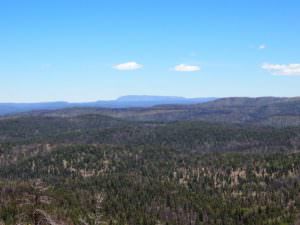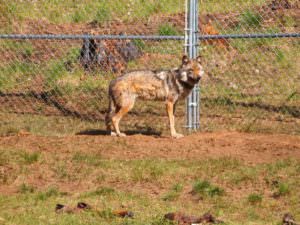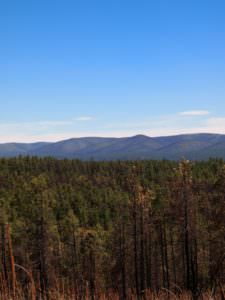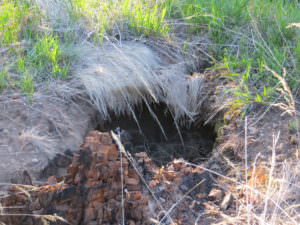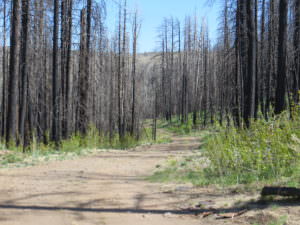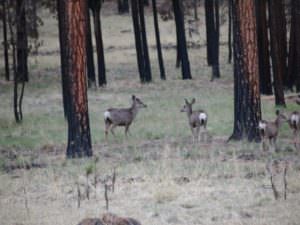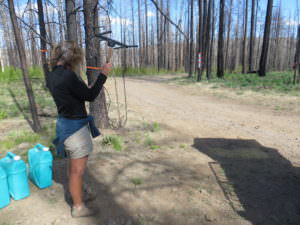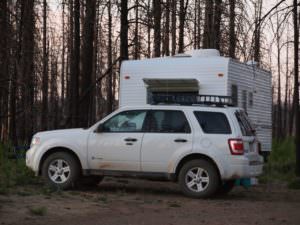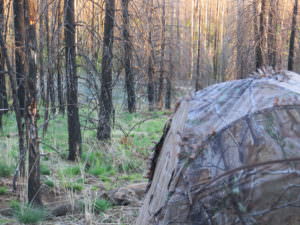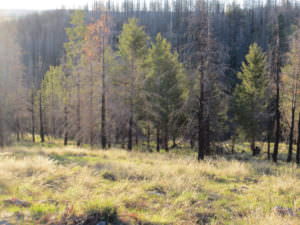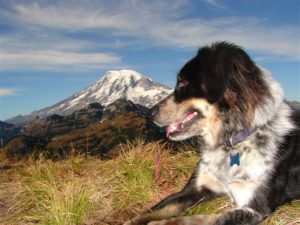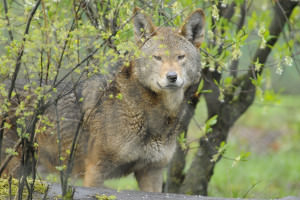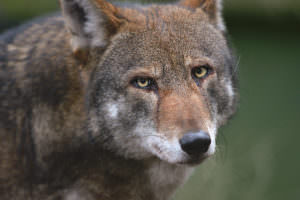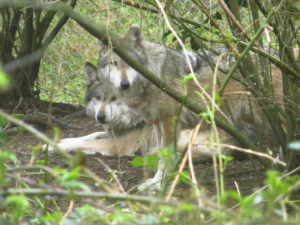Posts
Helping Save Mexican Wolves (#7) – hearing, seeing & tracking wolves
Nearly exterminated in the wild during by the 1930s, the Mexican wolf remains one of the most endangered mammals in North America. In May, Wolf Haven’s Director of Animal Care Wendy Spencer assisted in the care & observation of two wolves scheduled for future release. This is Part 7 of an ongoing series of blog posts about her experience in Arizona.
The remainder of the day was fairly uneventful. Erin had spent the day with Allison doing a telemetry flight, locating (by signal not visual) not only the AZ wolves, but the NM wolves as well. She was happy to report that they were able to pick up everyone’s signal and all the wolves were where they were supposed to be. Earlier that morning I had picked up M1107’s signal, but it was faint and he seemed to be tracking to the southwest, towards the Fort Apache Indian Reservation (FAIR), which was confirmed by their telemetry flight. Later that evening though, he was back, and for a few hours, his signal was very strong coming from the direction of the pen. I am ever amazed at how incredibly mobile these wolves are- M1107 easily traveled 40-50 miles in less than a 12 hour time span.
Periodically through the night the wolves’ howls would drift up to the trailer, waking me from sleep. Because I live on site here at Wolf Haven, I have become quite familiar with their lullaby so the first few times it took a moment for my mind to register that I was in the middle of the Alpine wilderness, listening to wild wolves.
The following morning at the blind was also fairly uneventful. I arrived at 4:45, just before the sun made its way over the ridge and though the wolves were already up and about, they paid me no mind. For the next 2 hours they would wander in and out of my field of view but the ravens would usually let me know when they were about to wander into sight. At any given moment there were at least 15 ravens hanging around, usually on the leftover carcasses and for the most part, the wolves ignored them- except when they didn’t. F1126 seemed to get the most irritated with them and on several occasions I observed her lower her head deliberately and run towards them, sending the ravens into a squawking flurry of black. They obviously didn’t take her threats very serious though because as soon as she moved on, they were back.
Later that day I headed out to spend the day in the field with Quinn. I am sure it was terribly mundane for him but for me, it was one of the best days ever! We drove to the near-by fire tower and climbed to the top to do telemetry checks on not only M1107 (who we hadn’t heard since the previous night) as well as the Maverick pack.
From our vantage point I could see almost
the entire recovery area in Arizona and even part of the Gila in New Mexico- so vast and rugged. To be able to look out as far as my eyes could see and know that the wolves were out there somewhere was simply awesome…… (to be continued)
Helping Save Mexican Gray Wolves (#5) – beautiful & pure howls
Nearly exterminated in the wild during by the 1930s, the Mexican wolf remains one of the most endangered mammals in North America. In May, Wolf Haven’s Director of Animal Care Wendy Spencer assisted in the care & observation of two wolves scheduled for future release. This is Part 5 of an ongoing series of blog posts about her experience in Arizona.
The following morning I headed out in the dark and made my way to the blind. Twenty minutes would pass before I saw any movement from the wolves so perhaps they had decided to sleep in that morning. If they detected my presence, they gave no indication, as they did not even glance in my direction the entire time I was there- a marked difference from the day before. They went about their morning routine of stretching, marking, eating off a carcass and chasing ravens- pretty uneventful but amazing nonetheless. One of things I was asked to do was to try and determine whether or not the female had pups. There was some indication that the female had whelped approximately 10 days earlier but after reading the log book entries detailing her behavior and then seeing her through the scope, she did not look or behave as if she was nursing pups. She was out the remainder of the time that I was at the blind and rather than having a “bagged up” appearance that would be consistent with nursing, her abdomen appeared tucked up.
As I watched F1126, all of a sudden in the distance, a low, melodious howl broke my focus and I listened as it drifted through the basin. I could see the pair so I knew it was not coming from them and it was decidedly wolf, so it must have been M1107. The pair did not respond but rather just stood on high alert, ears pricked forward in the direction of the howls. The serenade continued and after a few seconds, I thought I heard a second voice join the chorus but there had been no reports of other wolves in the area, so I assumed it was just an echo. Listening to the howls, I was moved beyond words- It was so beautiful and pure. After working with these animals in captivity for 15 years, to finally see and hear them on the landscape filled my heart and soul with overwhelming emotion. The howling continued off and on for the next 40 minutes and then there was silence.
When my 2 hours were up, I returned to camp and delivered the disappointing news about pups. The sun was now up and everything was awash in the color of the early morning sun. The customary spring winds had not yet kicked up so it was very silent (save for the birds). I knew elk were in the area because I had come to learn that their hooves make a very distinct sound when they hit the downed, dried aspen trees that clutter the forest floor.
Because the sun was in my eyes, it was hard to make out the orange and pink surveyors tape that marked the trail that led to and from the blind so I ended up veering slightly off the path. As I looked around for the footpath, a muffled, rustling sound caught my attention. I looked down and suddenly realized that I was about 2 feet away from a den entrance- badger most likely given the size – and not wanting to disturb the family further, I quickly hurried away. Further down the path I came across another den site, this one larger so most likely coyote. This was a fertile hillside…….. (to be continued)
Helping Save Mexican Gray Wolves (#4) – beauty from devastation
Nearly exterminated in the wild during by the 1930s, the Mexican wolf remains one of the most endangered mammals in North America. In May, Wolf Haven’s Director of Animal Care Wendy Spencer assisted in the care & observation of two wolves scheduled for future release. This is Part 4 of an ongoing series of blog posts about her experience in Arizona.
By the time Allison left, it was about 3:00 in the afternoon so after Erin and I got settled in the trailer and figured out who was sleeping where, I grabbed my journal and decided to go for a walk. The pen was in a southerly direction from camp so I decided to head north to see what I would find. I didn’t have to go far- only about a ¼ mile before I came to an open meadow on the northwest aspect of the ridge where our camp was located. There I sat in the afternoon sun, captivated by the beauty that surrounded me. Evidence of the fire was all around me but even in the midst of so much devastation there was such beauty and life. The tall, charred aspen were a stark contrast against the pristine blue sky and brilliant green of the young aspen regrowth as it danced in the afternoon wind. Ravens and songbirds soared over head and everywhere I looked, grasshoppers flitted about, the din of their collective chirping rivaling the sound of the aspen leaves rustling in the wind.
A few hundred feet away there was a group of mule deer grazing – we regarded one another briefly, and after giving me a dismissive glance, they went out their business. For hours I sat, Thoreau’s words “I went to the woods because I wished to live deliberately “repeatedly running through my mind. I felt grateful, blessed, alive. Once the afternoon sun began to sink below the far off ridge line, I decided to head back.
Sunset is early in the Apache- 7:30, so after a light dinner, it was time to turn in since we both had to be up early – 3:30am. Erin was going to spend a day in the field with the IFT and I needed to get to the blind at first light (4:45am). Throughout the night we took turns getting our telemetry readings- not only were we monitoring the pair, but there was also another wolf hanging around, M1107, the former alpha male of the now defunct Rim pack. His mate had been removed from the wild the previous year so now he just wandered his former range and the nearby Fort Apache Indian Reservation (FAIR), presumably in search of a new mate. We picked up his faint signal to the north of the pen during the night so we knew he was still in the area.
Helping Save Mexican Gray Wolves (#3) – base camp & the blind
Plans are being made for the first release IN FIVE YEARS of Mexican gray wolves into the wild! Nearly exterminated in the wild during by the 1930s, the Mexican wolf remains one of the most endangered mammals in North America. In May, Wolf Haven’s Director of Animal Care, Wendy Spencer assisted in the care & observation of two wolves scheduled for future release.
Once we were briefed at the Alpine office, Erin and I followed Allison, an AZGF employee out to the pen site. Located approximately an hour and a half outside of Alpine, we wound our way up into the hills, into the heart of where the Wallow fire ripped through in May of 2011, burning 538,000 acres. Eventually we turned off onto a dusty forest service road which we followed for about 18 miles until we came upon the travel trailer that would be our home base for the next week.
It was total luxury- not like any other back country backpacking that I had done- there were beds, solar power, propane heat, a refrigerator and stove (but no plumbing)- 5 star camping! We were given the essentials- water, a bathroom shovel, telemetry equipment and a hand held radio (in case of an emergency) and a log book for keeping track of our observations. Then, before dusk set in, we hiked on foot to the blind where we would be observing the wolves.
As the crow flies, the blind was about a mile from camp, but in order to come around the back side of the blind and be as unobtrusive as possible, we took more of a round- about path which lead us up several switchback trails to the top of a ridge and then down the other side. The blind was just a camouflaged pattern tent set up on the hillside about 300 feet from the pen. Inside the blind there was a spotting scope and a chair- everything we needed for watching wolves. That first day we did not stay long- perhaps only 10 minutes- just enough time to see the layout of the pen and get a glimpse of the wolves and their distinguishing marks so that we could tell the male apart from the female (i.e: radio collar color, coat color and pattern). Because there were 3 of us and the prevailing wind was coming from behind us, the wolves knew the moment we crested the ridge. They continued to keep a nervous eye on us the entire time we were there so as soon as we got our visuals, we quietly slipped away and returned to camp.
Back at camp we received our detail: telemetry readings every 2 hours, observation at the blind by one person only for two consecutive hours a day and even though the area was closed to the public, turkey hunting season still had a few weeks to go, so we needed to keep an eye out for anyone who might accidentally (or intentionally) wander into the area and inform them of the closure and ensure that they turned around…………(to be continued)
Helping Save Mexican Gray Wolves (#2)
Plans are being made for the first release IN FIVE YEARS of Mexican gray wolves into the wild! Nearly exterminated in the wild during by the 1930s, the Mexican wolf remains one of the most endangered mammals in North America. In May, Wolf Haven’s Director of Animal Care, Wendy Spencer assisted in the care & observation of two wolves scheduled for future release. (this is the second blog post about her experience.)
In early April we received word that the Interagency Field Team (IFT) was planning to initiate a release operation later in month. The plan was to move M1051 and pregnant F1126 from Sevilletta to a hard-sided acclimation pen in the Apache National Forest where they were to remain while the female whelped and the family acclimatized enough with the area so that once released, they would hopefully recognize it has home. And because this would be an extended period of time- at least 6 weeks- the IFT needed some help keeping an eye on the wolves and monitoring for signs of whelping activity. Maggie Dwire, who is with the United States Fish and Wildlife Service and serves as the Assistant Recovery Coordinator for the Mexican gray wolf program, put a call out to a few representatives from select facilities who participate in the Mexican wolf captive breeding program and asked for volunteers to come to AZ and “pen sit” the wolves.
As reticent as I am about leaving not only the sanctuary animals, but my own personal animals, I knew this was an opportunity of a lifetime and one that I could not pass up. On May 17, I flew to Albuquerque, NM, and the next morning, myself and Erin Kipp, a staff person from the Endangered Wolf Center, made the 4 hour trip to the office in Alpine, AZ, where we met several members of Arizona Game and Fish (AZGF), one of 5 agencies who make up the IFT. On the Arizona side, it is AZGF that see to the day-to- day management of the wolves on the ground. They have a dedicated staff who focus solely on the wolves and as I discovered, even though there are only approximately 38 free ranging wolves in Arizona (at last count), those wolves keep the staff plenty busy. Everything from tracking, to telemetry flights, to trapping and collaring, to managing livestock conflicts (to name but a few) falls under the purview of AZGF, so trying to pen sit wolves for 6 weeks would have significantly stretched their resources……….
SSP wolf update
Happy Monday everyone – A quick animal update:
The biggest news is we caught up quite a few of our male Species Survival Plan (SSP) animals for semen collection and banking last week. For two days we hosted the Point Defiance Zoo reproductive team as well as a reproductive specialist out of the St. Louis Zoo who is involved with the Mexican gray wolf program, and one of the vets we work with from Yelm Vet. Between all of the people, the wolves, and equipment, we still managed to all squish into the education room for the procedures.
We caught up our red wolf males, Tala and Jacob, on Thursday and the following day we caught up our three Mexican gray wolf pre-release brothers (M1066, M1067, M1135…[My] house names of Hobbs, Cejitos, and Slinky respectively). The catchup and procedures went well for everyone. Jacob’s samples were banked, but Tala’s samples had a low-ish sperm count. However, Ruby and Tala were seen tied just the day before so the timing for Tala’s collection wasn’t the best – the guess was that his ‘tank may have been empty’. The three brothers unfortunately didn’t have the best samples, but the team was still able to bank some of it. In addition, all of the wolves were given their ‘annuals’: vaccines, blood draw, and a physical exam by our vet. The wolves all recovered in their crates and were released, and thankfully everyone is doing fine after the procedure. In addition, all of the blood work looks good!
We’ve also had a fairly active breeding season so far. We have a total of four pairs of wolves recommended for breeding (as decided by the red and Mexican wolf SSP programs). We have seen both pairs of our red wolves tied (Jacob/Tamaska and Ruby/Tala), as well as one of our pre-release pairs of Mexican gray wolves (M752/F759 or house names of Coal/Fern).
We have an additional pair of pre-release Mexican gray wolves recommended, but haven’t seen them tied yet. This is a unique pair though, as the male is 15 years old! We’re all rooting for him, and keep in mind – just because we haven’t seen that pair tied doesn’t mean they haven’t. Now comes the waiting game…
Everyone else in the sanctuary is doing well.
Erik Wilber, Animal Care and Education Specialist




